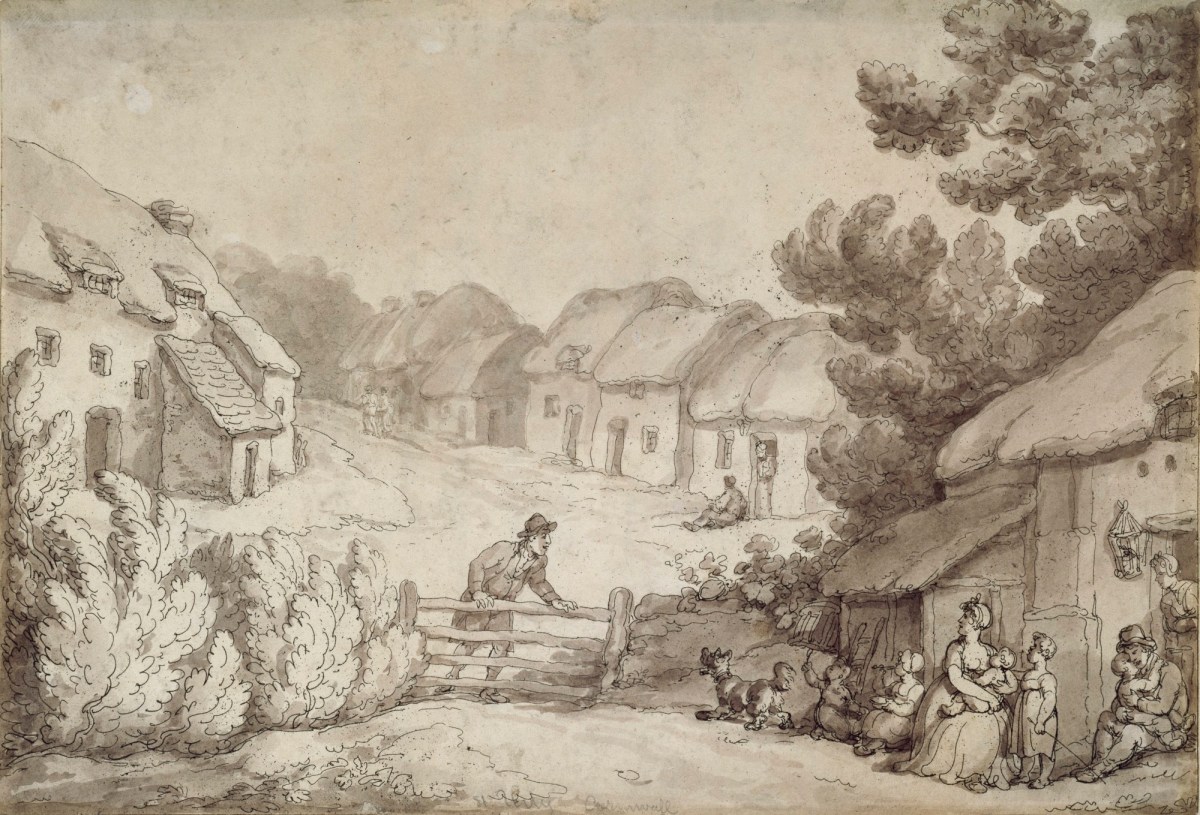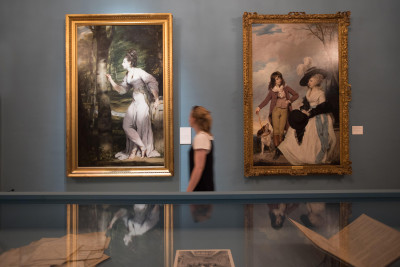
Thomas Rowlandson, Village scene with man at gate, ca. 1799-1818.
Pen and ink and wash on laid paper. 143 mm x 207 mm. © Photo: Royal Academy of Arts, London.
This image is not available to download. To licence this image for commercial purposes, contact our Picture Library at picturelibrary@royalacademy.org.uk
Village scene with man at gate, ca. 1799-1818
Thomas Rowlandson (1757 - 1827)
RA Collection: Art
This drawing depicts a man leaning over a gate with a woman and her family turning to look at him and a dog running up to greet him, which suggests that the man could be a friend or relative of the family. The family sit by a cottage and in the background are rows of cottages on either side of a path.
On the verso of the drawing is a pencil inscription from the poem 'The Pleasures of Hope' (1799) by the Scottish poet Thomas Campbell, but with some alterations, different words and omissions from the published version (the changes are indicated here by underlining):
- Mark the wretch
Whose wanderings never knew
The world's esteem that sooths tho'
half untrue
Whose erring heart the lash of sorrow
bore
Yet found not pity, when it erred no more.
[four lines omitted]
Ev'n he at even' should he chance to stray
Down by the hamlets hawthorn scented way
Where round the cot's romantic glade is seen
The spreading [blank] and the sloping green
Leans o'er its [blank] and thinks the while
Oh! that for me some home like this would smile
Some lowly [?roof] to yield my shivering form
Health in the breeze and shelter from the storm
It is possible that the scene reminded Rowlandson of this popular poem, which won instant recognition for its young poet when it was published in 1799. A number of previous poems had dealt with 'Pleasures' (of 'Memory' and 'Imagination', for instance) and others had also dealt with 'Hope', but Campbell's poem became the most popular of these. His poem also followed the trend in the period for sentimental tales. The author of one of the most famous of such stories, Henry Mackenzie, who published The Man of Feeling in 1771 and was also a Scot, immediately became Campbell's patron after reading the poem (William Beattie, ed., Life and Letters of Thomas Campbell, 1849, vol. 1, p. 254).
Rowlandson might have been considering that lines from this poem could be used as an epigram for a print of this subject. The changes in words, lack of punctuation and blank areas in this very quickly written inscription suggest that Rowlandson was writing from memory and was planning on filling in the blank areas later. The published poem for this verse reads:
And mark the wretch, whose wand'rings never knew
The world's regard, that soothes though half untrue,
Whose erring heart the lash of sorrow bore,
But found not pity when it err'd no more.
Yon friendless man, at whose dejected eye
The unfeeling proud one looks - and passes by,
Condemn'd on Penury's barren path to roam,
Scorn'd by the world, and left without a home-
Ev'n he, at evening, should he chance to stray
Down by the hamlet's hawthorn-scented way,
Where, round the cot's romantic glade, are seen
The blossom'd bean-field, and the sloping green,
Leans o'er its humble gate, and thinks the while-
Oh! that for me some home like this would smile,
Some hamlet shade, to yield my sickly form
Health in the breeze, and shelter in the storm;
There should my hand no stinted boon assign
To wretched hearts with sorrow such as mine;-
That generous wish can soothe unpitied care,
And Hope half mingles with the poor man's prayer.
From its first publication in 1799, Campbell's poem was accompanied by illustrations (this edition had four engravings). The fifth edition from 1801 had new illustrations, designed by Edward Francis Burney and engraved by James Heath, James Fittler and John Neagle. A new edition from 1818 had illustrations by Richard Westall, engraved by Charles Heath (James Heath's son). A mid-century edition had illustrations by Myles Birket Foster, George Thomas and Harrison Weir.
Both Edward Francis Burney (engraved by James Fittler) and Myles Birket Foster produced illustrations of this same moment in the poem. Both show a man leaning on a gate with a cottage in the background. It is possible that Rowlandson was going to provide illustrations to be published with the poem and so made this drawing. But he also may have intended to capitalise on the poem's popularity by creating a print of this memorable moment with a quote below.
On the recto of the drawing there is an inscription that seems to say 'St Tudy Cornwall', suggesting that this is where the scene is set. A great patron of Rowlandson, the banker Matthew Michell, owned Hengar House in St Tudy, near Bodmin, and the two often travelled around the West Country together (DNB). A drawing of similar-looking cottages has also been identified as depicting the same village (Village of St. Udy [sic], near Bodmin, Cornwall, reproduced in V. P Sabin, A Catalogue of Watercolour Drawings by Thomas Rowlandson, London, 1933, pl. CIII, p. 85). Michell had retired from his London banking firm to Cornwall in 1799 and Rowlandson visited him there often after this date. As 'The Pleasure of Hope' was published in 1799, both of these factors suggest that the drawing was made some time after this date, probably before Michell's death in 1818.
This work is one of several by Rowlandson that were in the collection of the artist Carel Weight RA, who bequeathed them to the Royal Academy.
Object details
143 mm x 207 mm
Start exploring the RA Collection
- Explore art works, paint-smeared palettes, scribbled letters and more...
- Artists and architects have run the RA for 250 years.
Our Collection is a record of them.



